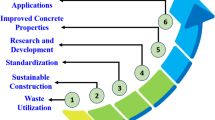Abstract
This paper evaluates the suitability of stabilized lateritic soils as highway and building (bricks) construction materials and the influence of locally available, cheap and environmental friendly stabilizer on the mechanical strength. The laboratory study employed four lateritic soil samples stabilized with varying amount of bamboo leaf ash (BLA) ranging from 2–8%. BLA was later kept constant at 5% and further added with lime (LSL) ranging between 2.5–10%. This resulted in four different LATERITE–BLA–LSL mix which are mix-1 (20:1:0.5), mix-2 (20:1:1), mix-3 (20:1:1.5) and mix-4 (20:1:2), respectively. The engineering properties of the specimens were evaluated through unconfined compression strength (UCS), California Bearing Ratio (CBR), compressive strength and water absorption. The UCS for the stabilized soils increased as BLA increased from 2 to 6% and the mix increased from mix-1 to mix-4, with maximum UCS observed between 5–6% BLA and mix-3 (7.5% LSL). The soaked and unsoaked CBR values, which ranged between 10–44 and 27–76%, respectively, satisfied the minimum requirement for most building standards for subgrade and sub-base of 10 and 30%, respectively. Results of BLA + LSL bricks indicated that compressive strength increased, while water absorption decreased with increase in the firing temperature and percentage of stabilization, which met the American Standard for Testing Materials (ASTM) standard specification for concrete building bricks. This study has shown the combined optimum improvement of soils and its suitability as subgrade, sub-base and building bricks construction materials.





Similar content being viewed by others
References
AASHTO (2011) Standard specifications for transportation materials and methods of sampling and testing. American Association of State Highway and Transportation Officials. Washington, D.C.
Adam EA, Agib ARA (2001) Compressed stabilised earth block manufacture in Sudan. Printed by Graphoprint for UNESCO, France, Paris
Akpokodje EG (1985) The stabilization of some arid zone soils with cement and lime. Q J Eng Geol Hydrogeol 18(2):173–180
Association TBI (2007) Specification for and classification of bricks. Retrieved from www.gobrick.com/portals/25/docs/technicalnotes/tn9a.pdf. Accessed 3 mar 2018
ASTM (2012) Standard test method for density, relative density (specific gravity), and absorption of coarse aggregate. ASTM International, West Conshohocken
ASTM (2017) Standard test methods for sampling and testing brick and structural clay tile. ASTM International, West Conshohocken
Brennan C (2017) Bamboo as an environmentally conscious alternative to polyester in hockey jerseys. Allegheny College Meadville, Pennsylvania
Chen C, Habert G, Bouzidi Y, Jullien A (2010) Environmental impact of cement production: detail of the different processes and cement plant variability evaluation. J Clean Prod 18(5):478–485
Das BM (2000) Fundamentals of geotechnical engineering. Brooks. Cole, Pacific Grove
Dwivedia VN, Singhb NP, Dasa SS, Singha NB (2006) A new pozzolanic material for cement industry: bamboo leaf ash. Int J Phys Sci 1(3):106–111
Gonen T, Yazicioglu S (2007) The influence of mineral admixtures on the short and long-term performance of concrete. Build Environ 42(8):3080–3085
Graham CW, Burt R (2001) Soil block home construction. Paper presented at the BTEC sustainable buildings III conference. Santa Fe, NM
Harunur Rashid BM, Ali K, Tarif MC, Ahmed U (2010) Long term effect of rice husk ash on strength of mortar. Word Academy of Science, Engineering and Technology, vol. 43. pp 740–743
Heathcote K (1991) Compressive strength of cement stabilized pressed earth blocks: strength of cement stabilized pressed earth blocks depends on cement content and compacted density—simple formula presented to predict strength based on variables. Build Res Inf 19(2):101–105
Houben H, Guillaud H (1986) Earth construction technology, 4 volumes. UNCHS (Habitat), Nairobi
Jahren P (2004) Greener concrete—the CO2 case—what are the opinions? Paper presented at the Eighth CANMET/ACI international conference on flyash, silica fume, slag and natural pozzolans in concrete. pp 219–315
Karaman S, Ersahin S, Gunal H (2006) Firing temperature and firing time influence on mechanical and physical properties of clay bricks. J Sci Ind Res 65:153–159
Kundu A (1993) National trends in housing-production practices: United Nations Centre for Human Settlements (Habitat), Nairobi
Makinde OO (2014) Housing delivery system, need and demand. Environ Dev Sustain 16(1):49–69
Marceau ML, Nisbet MA, Martha GV (2002) Life cycle inventory of Portland cement concrete, SN3011. Portland Cement Association, Skokie
NBRRI (2008) Technology innovation catalogue. Nigerian Building and Road Research Institute (Ed.), Abuja, Nigeria. pp 25–29
Rawi NFM, Jayaraman K, Bhattacharyya D (2013) A performance study on composites made from bamboo fabric and poly (lactic acid). J Reinf Plast Compos 32(20):1513–1525
Stajanča M, Eštoková A (2012) Environmental impacts of cement production. Civil Engineering Faculty, Institute of Architectural Engineering, Technical University of Košice, vol 737. pp 296–302
Standard B (2004) 1377 (1990) Methods of test for soils for civil engineering purposes. British Standards Institution, London
Symons MG, Poli DC (1999) Properties of Australian soils stabilised with cementitious binders: volume I and II. Structural materisls and assemblies group, Univ. of South Australia, The Levels, South Australia.
Thagesen B (2003) Highway and traffic engineering in developing countries: CRC Press, Boca Raton
Utodio NF, Ekandem ES, Egege CC, Ocholi M, Atakpu OD, Nwaigwe DN (2015) Investigation of the effect of bamboo leaf ash blended cement on engineering properties of lateritic blocks. J Sustain Dev Stud 8(1):193
Villar-Cociña E, Morales EV, Santos SF, Savastano H, Frías M (2011) Pozzolanic behavior of bamboo leaf ash: characterization and determination of the kinetic parameters. Cement Concr Compos 33(1):68–73
Walker PJ (2004) Strength and erosion characteristics of earth blocks and earth block masonry. J Mater Civ Eng 16(5):497–506
Whitlow R (1995) Basic soil mechanics, 3rd edn. Addison Wesley Longman Limited, Edingburg Gate
Acknowledgements
The authors acknowledge the department of Geology, Federal University of Technology, Akure, Ondo, Nigeria for assisting in geotechnical laboratory analysis.
Author information
Authors and Affiliations
Corresponding author
Rights and permissions
About this article
Cite this article
Inim, I.J., Affiah, U.E. & Eminue, O.O. Assessment of bamboo leaf ash/lime-stabilized lateritic soils as construction materials. Innov. Infrastruct. Solut. 3, 32 (2018). https://doi.org/10.1007/s41062-018-0134-7
Received:
Accepted:
Published:
DOI: https://doi.org/10.1007/s41062-018-0134-7




